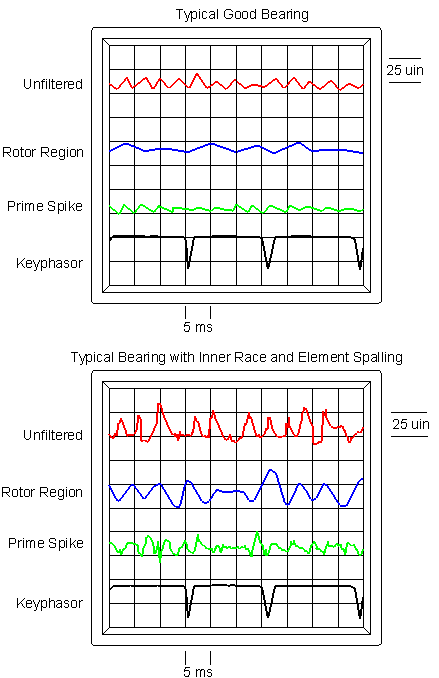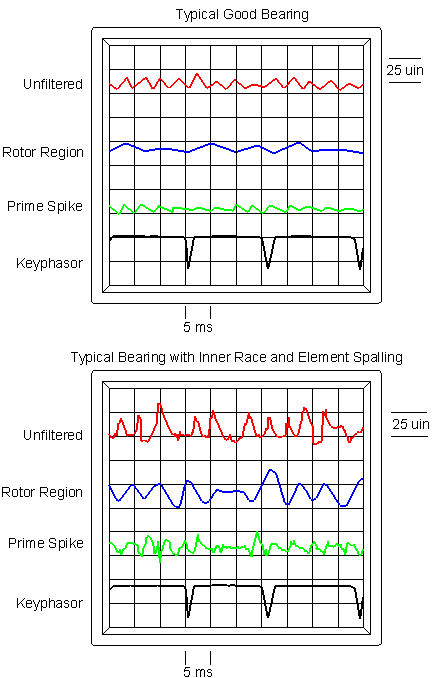How the REBAM Concept Works and Field Application of REBAM
Introduction
The ability to monitor and analyze machinery utilizing rolling element bearings is a unique challenge. Most monitoring and analysis techniques used today use a casing vibration instrumentation system to determine rolling element bearing condition. Due to problems introduced by either the instrumentation itself or by interference for extraneous vibration, limited success has been achieved. The purpose of this applications note is to outline how vibration measurements made directly at the bearing outer ring, which contains the outer race, can greatly improve the ability to monitor and analyze rolling element bearing condition.
How the REBAM Concept Works
The concept of measuring the deflections of a rolling element bearing outer ring during operation was originally demonstrated by Shapiro of the Franklin Institute using strain gages attached to the bearing’s outer ring. This concept was further improved upon by G. J. Phillips of the David W. Taylor Naval Research and Development Center using noncontact fiber optic techniques. Bently Nevada Corporation adopted this noncontact concept and, as an alternative to the fiber optic sensor, developed a high-gain, low-noise eddy current proximity transducer to measure the deflections of a rolling element bearing’s outer ring. This transducer is called REBAM®, which is an acronym for Rolling Element Bearing Activity Monitor.
A high-gain eddy current proximity transducer is mounted through the bearing housing observing the external surface of the bearing outer ring (Figure 1). The bearing outer ring contains the bearing’s outer race. During bearing operation, the bearing’s outer ring deflects minutely as a function of applied forces. The REBAM® transducer measures the very small (microinch/micrometre) deflections are measured in terms of displacement and are typically in the range of 2 to 300 microinces (0.5 to 8 micrometres). Under typical operating conditions, the signal from a good bearing, observed on an oscilloscope, displays a smooth signal with few or no “spikes” of significant amplitude. When an internal bearing flaw (e.g. , inner race, outer race, rolling elements) is present, “spikes” of significant amplitude occur on the vibration signal (Figure 2). In order to clarify how the REBAM® signal can be used to evaluate rolling element bearing condition, some discussion of rolling element bearing vibration characteristics is justified.
Rolling Element Bearing Vibration Characteristics
The vibrations produced by machines with rolling element bearings occur in three frequency regions: (1) Rotor Vibration region, (2) Prime Spike (element passage) region and (3) the High Frequency region. The High Frequency region measurement (above 5 Khz) is for specialized applications and will not be discussed in this applications note.
1. Rotor Vibration Region
Rotor-related vibration normally occurs in the range of 1/4 to 3 times shaft rotative speed (1/4Xx – 3x) and, when using the REBAM® instrumentation system, is measured in terms of displacement. Many rolling element bearing failures are the direct result of a rotor-related malfunction (e.g., unbalance, misalignment, or rotor instability). If the rotor-related vibration data is not monitored for identification and correction of rotor-related malfunctions, the bearing will chronically fail.
2. Prime Spike (Element Passage) Region
The second vibration frequency region to monitor for machines with rolling element bearings is the Prime Spike (element passage) region. A classical characteristic of rolling element bearings is the generation of specific frequencies based on the bearing geometry, number of rolling elements and the speed at which the bearing is rotating. These “bearing-related” frequencies are generated even by a new bearing, but the amplitudes are very small. Prime Spike is a term used by Bently Nevada to describe a vibration frequency range which includes those bearing frequencies that are generated by the rolling elements traversing either an inner or outer race flaw. This frequency range is normally 1 to 7 times the Outer Race Element Passage rate (1-7EPx). The Outer Race Element Passage rate (EPx) is defined as the rate at which the rolling elements pass a point on the outer bearing race.
Field studies indicate that approximately 90% of all bearing failures are related to either an inner or outer race flaw. By establishing a frequency band around the predominant bearing failure frequencies and filtering out the rotor-related vibration frequencies, it is possible to gain improved monitoring of bearing condition. The other 10% of rolling element bearing failures are related to either a rolling element flaw or a cage flaw. A cage flaw shows up in the Rotor Vibration region below ½ shaft rotative speed. An element flaw would show up in the Prime Spike region for a casing-mounted transducer, but shows up in the Rotor region in a REBAM® signal.
The exact calculated rolling element bearing frequencies are essentially of academic interest, because (1) it frequently occurs that any flaw on any element rapidly generates secondary flaws on other elements, and (2) knowledge of the existence and extent of a flaw is vital; however, knowledge of which element has the flaw is not vital because the entire rolling element bearing is normally replaced, not just the damaged element.
Based on field observations of many rolling element bearings by Bently Nevada and our customers, most of the information on the condition of rolling element bearings and warning of their failure occurs in the Prime Spike region (1 – 7EPX). Information about rotor behavior generally occurs in the region between 1/4 and 3 times shaft rotative speed (1/4x – 3x). Information at very high frequencies (8EPx and higher to the megahertz region) may contain very early warning information, as well as other data concerning machinery condition (e.g., rubs, gear noise, cavitation, valve noise, etc.). However, the principle and vital data to determine rolling element bearing condition is contained in the Prime Spike region (1 – 7EPx).
Field Application of REBAM ®
Through the use of electronic filters, the REBAM® signal is separated into the Rotor Vibration and Prime Spike regions. Typical Prime Spike amplitudes are 10 to 50 microinches (0.25 to 1.3 micrometres) for a good bearing and 2 to 5 times that for a damaged bearing. However, the amplitude of the REBAM® signal is highly dependent upon the amount of loading on the elements as they pass the location of the probe, and it is therefore not possible to give broad guidelines for what means a healthy or a damaged bearing. A common practices is to take readings on what is known to be a healthy bearing and set the monitor Alert and Danger alarm levels at 1.5 and 2 times the baseline level. Field and lab tests confirm that using these alarm levels provides adequate failure protection.
Displaying the REBAM® Rotor Vibration and Prime Spike signals on an oscilloscope provides an enhanced view of bearing condition. The primary purpose for monitoring the Rotor Vibration region is to watch for rotor-related malfunctions (unbalance, misalignment, instabilities, etc.); however, this region should not be overlooked as an indicator of bearing damage. Studies have shown that inner race and element spalling can produce significant amplitude increases in the Rotor Region of the REBAM® signal. The Prime Spike signal is used as an indicator of bearing problems. When a bearing problem occurs, the Prime Spike vibration signal will display significant amplitude “spikes” (Figure 2). The presence of any spiking on the oscilloscope display of the Prime Spike signal is a general indication that a bearing flaw exists. An exception to the “spiking rule” is when the rotor is either severely unbalanced or is experiencing a large steady state load. If a large steady state load becomes present, the Prime Spike amplitude will increase due to the extra loading on the elements as they pass the REBAM® probe location. The increase in load causes a corresponding increase in deflection of the outer ring. Since this occurs at each element pass, the vast majority of the amplitude increase occurs at the Outer Race Element Pass frequency. The monitor may show indication of bearing damage by giving an alarm on the Prime Spike region, but upon observing the REBAM® signal on a oscilloscope one would see a lack of spiking in the waveform (unless actual bearing damage had occurred), leading to the conclusion that the bearing is simply overloaded and not (yet) damaged.
In the presence of large imbalance forces, an increase in Rotor region amplitude will occur. Upon observation of the signal it will be apparent that the 1X amplitude is excessive and that the machine is in need of balancing. If either of these conditions is not corrected, the bearing will fail.
Benefits of using REBAM ®
The REBAM® system offers a very high signal-to-noise ratio when compared to casing-mounted accelerometer or velocity transducer measurements (Figure). System signal-to-noise ratio is defined as the ration of the amplitude of a desired signal at any point to the amplitude of noise signals at that same point.
Additional signal-to-noise improvement is obtained through the use of electronic filters. The REBAM® vibration signal is separated into two regions, Rotor Vibration and Prime Spike. This signal separation improves the signal-to-noise ratio for both regions. Results indicate this signal separation technique makes REBAM® two to eight times more sensitive to bearing faults than casing-mounted transducers.
Because the REBAM® system measures vibration directly at the rolling element bearing’s outer ring, several benefits from this type of measurement can be derived. The REBAM® system measures displacement relative to the machine case and is therefore isolated from extraneous vibrations (e.g., structural resonances, steam throttling, pump cavitation, gear noise, etc.) which often mask the bearing defect signals when casing mounted transducers are employed. REBAM® is a direct vibration measurement device and does not experience interface losses that can cause attenuation of the bearing’s vibration signal. Studies indicate that traversing an interface (e.g., water jackets, double cases, etc.) can attenuate a vibration signal by a factor of ten (20dB) or more.
An additional REBAM® benefit over casing-mounted transducers is that, because a probe is mounted at each bearing, REBAM® can identify the defective bearing. Casing-mounted transducers normally indicate that a vibration problem is present but do not identify the exact location without complicated and detailed analysis. Therefore, if the primary purpose of the vibration monitoring system is to be able to monitor individual rolling element bearing condition, REBAM® should be installed.
Typical Installation Considerations and Pitfalls
- REBAM® probes are designed to operate with 1000/4000 series carbon steel and most magnetic steels used in rolling element bearing construction. The transducer is calibrated at the factory using an AISI 4140 steel target. REBAM® transducers have been shown to operate well with 52100 steel (common in rolling element bearings) and to maintain linearity and proper scale factor within 5 percent. If the observed metal is other than those mentioned, Bently Nevada should be contacted, as the REBAM transducer will require special calibration. If this is overlooked, sensitivity errors can be introduced.
- When installing REBAM® on ball bearings and Bently Nevada recommended probes (3300 series REBAM® probes, or 7200 series 5mm with either 3/8-24 threads or M10x1 threads) are installed, no bearing housing relief is required to eliminate probe side view effects. It is strongly recommended to install REBAM® probes that require no bearing housing relief. If excessive relief is machined into the bearing housing, the possibility of failing the bearing’s outer ring due to fatigue, induced by the cyclic flexure of the ring, is greatly increased. Bearing manufacturers state that the bearing housing relief should be exceed ½ the spacing between the rolling elements. The maximum allowable circumferential relief can be approximated by the following formula:
1.5D/N = Maximum allowable relief D = Diameter of Bearing Outer Rings N = Number of Rolling Elements
When installing REBAM® on roller bearings (including cylindrical, tapered and spherical roller bearings) the load distribution at the contact of the element with the outer race makes it necessary to use a housing relief to obtain an appropriate amount of outer ring deflection. The same guidelines should be used to determine the diameter of the relief. If the geometry of the bearing is not known, Bently Nevada can provide this information if provided with the bearing manufacturer and model number. - The REBAM® probe must be mounted perpendicular to the centerline of the bearing’s outer ring. If the mounting hole is drilled at an angle (i.e., not perpendicular) to the centerline of the bearing’s outer ring, uncalibrated and abnormally low peak-to-peak readings can occur.
- The probe should never be allowed to contact the bearing’s outer ring during operation (Figure 4). If this occurs, the probe tip would likely be damaged.
- The probe lead should not be used to screw the probe into the bearing housing. The probe lead is permanently attached to the probe housing and a broken lead can occur.
- It is recommended to obtain the Bently Nevada Applications Note AN028 “Proximity Probes and Related Accessories – A General Guideline for Installation Considerations and Practices” for a more complete guideline on how to handle and install proximity probes.
Summary
Monitoring and analysis of machinery utilizing rolling element bearings with casing-mounted transducers (e.g., velocity transducer, accelerometer) require complicated and detailed analysis to determine rolling element bearing condition. The REBAM® system provides a simpler and more direct method for determining rolling element bearing condition with the added capability to also monitor the machine’s condition. REBAM® should be strongly considered for critical machines that utilize rolling element bearings and require continuous monitoring. Machine criticality is defined by the three factors of (1) safety (2) lost production and (3) expense of repair. Examples of machines that fit into the critical machine category are boiler draft fans, chiller units, high speed plant air compressors, primary production pumps, etc.
Another important factor to consider when determining the type of monitoring system to install on a machine utilizing rolling element bearings is machine speed. Casing-mounted transducers used on machines that operate at speeds below 900 rpm do not provide an optimal monitoring system due to the physical mechanics of the measurement and the sensitivity characteristics of typical transducers. On the other hand, the frequency response for REBAM® (0 to 10 Khz) not only provides excellent outputs for high speed machines, it also provides the same excellent outputs for low speed machine applications and should be strongly considered when it is required to detect rolling element bearing condition for a low speed machine. Examples of machines that fit into the low speed machine category are paper machines, centrifuges, cooling tower fans, dryers, pumps, etc. REBAM® should be considered for any machine that utilizes rolling element bearings where rolling element bearing condition information is needed.






